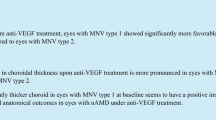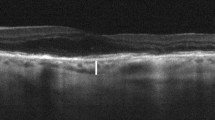Abstract
Purpose
The aim of this study was to evaluate subfoveal choroidal thickness (SFCT) as a marker of outcome in real-world treatment of diabetic macular edema (DME) and to correlate it with choroidal thicknesses (CT) collected around the fovea.
Methods
Prospective interventional case series included a total of 126 eyes from 126 patients with recently diagnosed DME treated with a 3-monthly loading dose of ranibizumab or aflibercept and PRN thereafter until 24 months (M). CT was manually measured in the central 3500 μm area, subfoveally (SFCT), at 1750 μm right and left from the center in the horizontal plane and at 1750 μm up and down from the center in the vertical plane, by OCT. Anatomic (10% decrease in central retinal thickness) and functional (gain ≥ 5 letters) responses were assessed using univariate and multivariate analyses. The areas under ROC curves were used to assess whether baseline SFCT was a predictor of outcome.
Results
CT significantly decreased in all follow-ups (3 months after the 3 injections’ loading dose (3M), 6 months (6M), 12 months (12M), 18 months (18M), 24 months (24M)). SFCT and other CT parameters are correlated. SFCT decrease from baseline was related with treatment (p = 0.003 to p < 0.001) but not with anatomic (3M, p = 0.858; 6M p = 0.762) or functional response (3M, p = 0.746; 6M, p = 0.156). SFCT was not found to be predictive of anatomic (AUC = 0.575, p = 0.172) or functional (AUC = 0.515, p = 0.779) outcome.
Conclusions
SFCT is a reliable marker of choroidal thickness. Baseline SFCT decreased with anti-VEGF treatment but did not predict DME outcome.






Similar content being viewed by others
References
Diabetic Retinopathy Clinical Research N, Elman MJ, Aiello LP, Beck RW, Bressler NM, Bressler SB, Edwards AR, Ferris FL III, Friedman SM, Glassman AR, Miller KM, Scott IU, Stockdale CR, Sun JK (2010) Randomized trial evaluating ranibizumab plus prompt or deferred laser or triamcinolone plus prompt laser for diabetic macular edema. Ophthalmology 117:1064–1077.e35. https://doi.org/10.1016/j.ophtha.2010.02.031
Ashraf M, Souka A, Adelman R (2016) Predicting outcomes to anti-vascular endothelial growth factor (VEGF) therapy in diabetic macular oedema: a review of the literature. Br J Ophthalmol 100:1596–1604. https://doi.org/10.1136/bjophthalmol-2016-308388
Lutty GA (2017) Diabetic choroidopathy. Vis Res 139:161–167. https://doi.org/10.1016/j.visres.2017.04.011
Campos A, Campos EJ, Martins J, Ambrosio AF, Silva R (2017) Viewing the choroid: where we stand, challenges and contradictions in diabetic retinopathy and diabetic macular oedema. Acta Ophthalmol 95:446–459. https://doi.org/10.1111/aos.13210
Nourinia R, Ahmadieh H, Nekoei E, Malekifar P, Tofighi Z (2018) Changes in central choroidal thickness after treatment of diabetic macular edema with intravitreal bevacizumab correlation with central macular thickness and best-corrected visual acuity. Retina 38:970–975. https://doi.org/10.1097/IAE.0000000000001645
Early Treatment Diabetic Retinopathy Study research group (1985) Photocoagulation for diabetic macular edema. Early treatment diabetic retinopathy study report number 1. Arch Ophthalmol 103:1796–1806
Esen F, Kostek M, Emekli AS, Eraslan M (2016) Double-organ bias in published randomized controlled trials of glaucoma. J Glaucoma 25:520–522. https://doi.org/10.1097/IJG.0000000000000369
Meng W, Butterworth J, Malecaze F, Calvas P (2011) Axial length of myopia: a review of current research. Ophthalmologica 225:127–134. https://doi.org/10.1159/000317072
Lains I, Figueira J, Santos AR, Baltar A, Costa M, Nunes S, Farinha C, Pinto R, Henriques J, Silva R (2014) Choroidal thickness in diabetic retinopathy: the influence of antiangiogenic therapy. Retina 34:1199–1207. https://doi.org/10.1097/IAE.0000000000000053
Lee SH, Kim J, Chung H, Kim HC (2014) Changes of choroidal thickness after treatment for diabetic retinopathy. Curr Eye Res 39:736–744. https://doi.org/10.3109/02713683.2013.867064
Yiu G, Pecen P, Sarin N, Chiu SJ, Farsiu S, Mruthyunjaya P, Toth CA (2014) Characterization of the choroid-scleral junction and suprachoroidal layer in healthy individuals on enhanced-depth imaging optical coherence tomography. JAMA Ophthalmol 132:174–181. https://doi.org/10.1001/jamaophthalmol.2013.7288
Rayess N, Rahimy E, Ying GS, Bagheri N, Ho AC, Regillo CD, Vander JF, Hsu J (2015) Baseline choroidal thickness as a predictor for response to anti-vascular endothelial growth factor therapy in diabetic macular edema. Am J Ophthalmol 159(85–91):e81–e83. https://doi.org/10.1016/j.ajo.2014.09.033
Adhi M, Alwassia AA, Duker JS (2013) Analysis of choroidal thickness in eyes treated with focal laser photocoagulation using SD-OCT. Can J Ophthalmol 48:535–538. https://doi.org/10.1016/j.jcjo.2013.05.010
Margolis R, Spaide RF (2009) A pilot study of enhanced depth imaging optical coherence tomography of the choroid in normal eyes. Am J Ophthalmol 147:811–815. https://doi.org/10.1016/j.ajo.2008.12.008
Vujosevic S, Torresin T, Berton M, Bini S, Convento E, Midena E (2017) Diabetic macular edema with and without subfoveal neuroretinal detachment: two different morphological and functional entities. Am J Ophthalmol 181:149–155. https://doi.org/10.1016/j.ajo.2017.06.026
Diabetic Retinopathy Clinical Research, N, Browning DJ, Glassman AR, Aiello LP, Beck RW, Brown DM, Fong DS, Bressler NM, Danis RP, Kinyoun JL, Nguyen QD, Bhavsar AR, Gottlieb J, Pieramici DJ, Rauser ME, Apte RS, Lim JI, Miskala PH (2007) Relationship between optical coherence tomography-measured central retinal thickness and visual acuity in diabetic macular edema. Ophthalmology 114:525–536. https://doi.org/10.1016/j.ophtha.2006.06.05217
Gerendas BS, Waldstein SM, Simader C, Deak G, Hajnajeeb B, Zhang L, Bogunovic H, Abramoff MD, Kundi M, Sonka M, Schmidt-Erfurth U (2014) Three-dimensional automated choroidal volume assessment on standard spectral-domain optical coherence tomography and correlation with the level of diabetic macular edema. Am J Ophthalmol 158:1039–1048. https://doi.org/10.1016/j.ajo.2014.08.001
Armstrong RA (2013) Statistical guidelines for the analysis of data obtained from one or both eyes. Ophthalmic Physiol Opt 33:7–14. https://doi.org/10.1111/n12009
Funding
This work is funded by the Portuguese Foundation for Science and Technology (Fundação para a Ciência e a Tecnologia, FCT), Strategic Project (UID/NEU/04539/2013), and COMPETE-FEDER (POCI-01-0145-FEDER-007440). EJC was financially supported by the FCT Postdoctoral Fellowship SFRH/BPD/93672/2013, through the European Union and National funds and co-funded by Human Capital Operating Programme (Programa Operacional do Capital Humano, POCH). The sponsor had no role in the design or conduct of this research.
Author information
Authors and Affiliations
Contributions
AC: acquisition, analysis, interpretation of data, and drafting of the manuscript. EC: interpretation of data, administrative, technical, editorial, and submission support. Do Carmo: data collection, scoring, and statistical analysis. MP: mathematics and statistical analysis. JS: critical revision. AA: revision of the manuscript and interpretation of data. RS: concept, design, supervision, and revision.
Corresponding author
Ethics declarations
Conflict of interest
Rufino Silva is a member of the Advisory Boards for Bayer, Alcon, Alimera, Allergan, Novartis, and Thea. All other authors certify that they have no affiliations with or involvement in any organization or entity with any financial interest (such as honoraria; educational grants; participation in speakers’ bureaus; membership, employment, consultancies, stock ownership, or other equity interest; and expert testimony or patent-licensing arrangements), or non-financial interest (such as personal or professional relationships, affiliations, knowledge, or beliefs) in the subject matter or materials discussed in this manuscript.
Ethical approval
All procedures performed in studies involving human participants were in accordance with the ethical standards of the institutional research committee and with the 1964 Helsinki declaration and its later amendments or comparable ethical standards.
Informed consent
Informed consent was obtained from all individual participants included in the study.
Electronic supplementary material
ESM 1
(DOCX 90 kb)
Rights and permissions
About this article
Cite this article
Campos, A., Campos, E.J., do Carmo, A. et al. Choroidal thickness changes stratified by outcome in real-world treatment of diabetic macular edema. Graefes Arch Clin Exp Ophthalmol 256, 1857–1865 (2018). https://doi.org/10.1007/s00417-018-4072-z
Received:
Revised:
Accepted:
Published:
Issue Date:
DOI: https://doi.org/10.1007/s00417-018-4072-z




